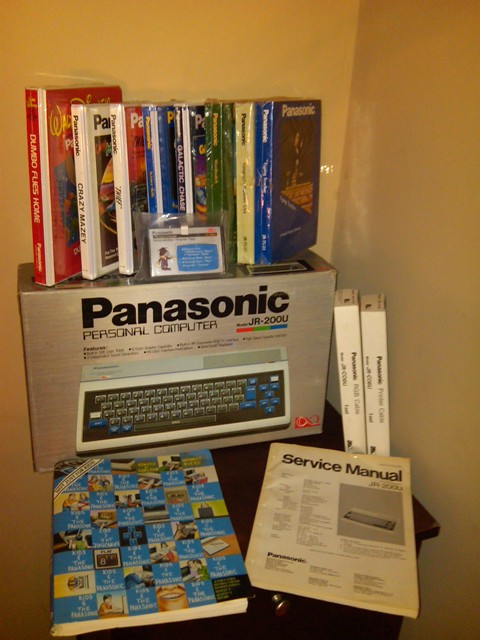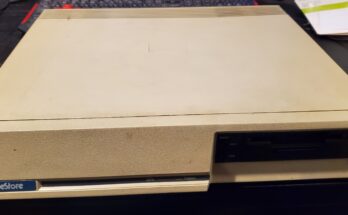I’ve recently acquired a collection of interesting classic PC related items. Among those items was a computer I have never heard about. It’s a Panasonic brand computer called JR-200U.
Built like a smaller (and more solid feeling) Commodre 64, this all-in-one unit has a built-in RF modulator to connect directly to a TV. It comes with 32K of RAM, which is unexpandable. Other ports it has are for a cassette interface, RGB monitor, RS-232, audio out, and Atari compatible joystick ports.
Along with the computer, I received eight different applications for it (on cassette), a demo program cassette, custom printer cable, custom RGB cable, cassette cable, aftermarket learning guide, and an official factory service manual.
As of this writing, I have not turned on the JR-200U. Although it has previously been used, many of the extras it came with are still in the original unopened condition. All of the software except the demo tape and one game is still shrinkwrapped. The RGB and printer cable are still stapled in their packaging. I would sure like to try those cables out, but the entire kit is in such pristine condition that the “collector” in me wants to leave it alone.
I’ll continue to research the item. Reading the service manual might reveal some hidden secrets about it. I will certainly post whatever information I discover in a future article.
If you really want to see some detailed reverse-engineering notes on the JR-200U, visit Marq’s website at: http://www.kameli.net/marq/?page_id=1270




Hello there.
I’ve just bought a JR-200U off Ebay and was searching for some information. Unlike yours, mine is in poor condition and didn’t function. I socketed the soldered mask ROM’s and as I suspected the BASIC ROM had failed – easily fixed by burning an EPROM. After some keyboard trace repairs it’s now fully functioning, though cosmetically it’s not too pretty because some of the rubber keys have damage and the key is missing for which I have improvised a temporary replacement.
Anyway, I found your excellent example on the net and spotted the service manual which you say has the schematics. Would it be too much to ask for a scanned copy of the schematics?
If it’s too much trouble I will understand, but as hardware info is difficult to find for this little computer I will jump at any chance 🙂
Thanks!
clockmeister@internode.on.net
http://users.on.net/~clockmeister
I’ll see what I can get together.
Sorry for the delayed response. I haven’t been keeping up on this site as much as I wanted to. Did you get your JR-200U working yet?
Jeff,
Is there any chance you still have the JR-200 stuff? I am actually the author of the “Thief” and never new whether or not it was published. I see from your photo that it was. I would love to hear about it.
Bob
Hi Bob!
Yes, I still have the JR-200, although I still have yet to actually hook it up and operate it. I want to thank you for contacting me about it. You’ve certainly given me incentive to hook it up as soon as possible.
My copy of the game is still shrink-wrapped, but I can post some close-up pictures of the game case and media if you’d like. After all, what good is a rare game such as this if it hasn’t been played. I just hope the tape is still in good shape.
Jeff
Jeff:
This is a really belated response and I think you may have sent me some information a couple of years ago after I got my JR-200 working. Anyway, I have lost your email address and I have just been contacted by the author of the game “Thief” which seems to be in your collection and he wishes to make contact with you as he wrote the game for the introduction of the JR-200 at CES and did not know if it was officially released.
Can you please send me your email address to pass on.
Thank you!
Sure! Just use ‘admin’ at this domain (vintagevolts.com) for the email address. I dug up that “Thief” game. It’s still in its shrink wrap. I look forward to his response!
Hi,
I’d love to get my hands on that service manual, as it might contain some new insight on the machine. I’ve been hacking the JR-200 with very little documentation:
In case the link’s not visible:
http://www.kameli.net/marq/?page_id=1270
Very informative site you have there. I think I visited it at one time. I was impressed with the well documented, extremely technical detail you provided. It reminded me of the technical details Commodore provided for their VIC-20 and C-64.
The hardware and software for a “coder’s cable” are almost done. It should let programming-oriented people upload their files from a PC host fast. The current transfer speed is around 5k/s – about 20x the cassette port 🙂
Would it be possible to get that service manual of yours scanned? There are still some unknown features that would warrant further study.
I know this reply is going under an article I wrote quite a while ago, but I forgot I even had the service manual! It might take some time to scan it in its entirety, but I can get it done. What specific details are you looking for, so I can at least get that information to you first?
At least the expansion bus pinout would be valuable, as well as any info on the main CPU. And as an update: the transfer cable/module is done, now just waiting for a working Arduino to write the final version of the software.
I need to clean up some of the pages, but the service manual is listed in the DOCS section of the website. A link to that section is at the top of the page.
Excellent, thank you! I’ll surely check it soon and update my page accordingly.
I’m happy to announce that the first version of the transfer cable is finished and published now. See the standard location 🙂 It still won’t work with games, so it’s mostly useful for coders only. Due to last minute fixes the transfer speed increased to 8kB/s.
When I get a chance to break out my system, I’ll look into your cable. Thanks for the contribution to the JR-200U community.
I finally had a chance to read your notes about the transfer cable. Excellent work!
I also had a chance to read the other JR-200 info you posted. Very useful stuff! Sometimes I wish I had the patience to do that kind of reverse engineering on my own.
🙂
Just finished scaning some developer docs I aquired a while ago.
They are not great, but may be helpful.
http://hcvgm.org/Static/Manuals/JR-200/
They will be going up with my JR-200 pages, but I have to finish updating the APF IM and finish the Interact pages first.
Nice to see more info out there than I could find before.
Heya, I’m looking for some information on the type of RGB that the JR-200U outputs; do you know anything about it? Would it be possible for you to please check the packaging of the custom RGB cable, and tell me exactyl what it says and what kind of connector it has?
Best regards,
Jordan